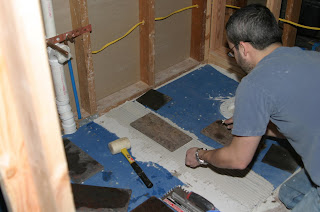When it comes to knee walls and insulation, there is a lot of controversy over the best way to insulate. Do you insulate just the knee walls and ceiling of floor below and leave a cold zone behind them for air flow and to prevent ice damming.
I don't have the luxury of having your standard knee wall setup as I am using that space for built-in dressers and a built-in bed. So I have insulated the rafters with R21 insulation. But when you pick clothes out of the dresser, the clothes are cold.
I read about the Atticat Blown-In Insulation system and thought it was great because it was less messy than the cellulose hopper type systems.
I figured I needed 5 bags of insulation and I could fill the entire cavity behind the built-in dressers. Not enough to warrant a free blower rental, so I figured we would just deal with some cold clothes :0
But then the friend that is always helping me with my projects bought a house and wanted to increase the R30 that he had in his attic to R60. This would work perfectly because we would be able to complete both insulation projects in 1 day.
That was this past weekend. The Friday before insulation Saturday, we went to Home Depot and bought 20 bags of insulation and rented the machine. If you buy 10 bags or more you get the machine rental for free. So, Saturday morning we start assembling things and getting things ready.
I take my extension cord, plug it into the machine and nothing. The machine won't turn on. Pull out my multimeter and we are getting 120V to the cord. The machine only requires a 15amp circuit, so I know that my 20amp circuit is more than adequate.
We bring it back to Home Depot. The tool rental worker plugs in his cord and VOILA, turns on...
I noticed that he is using a much beefier cord than my 10amp cord. I mention this and he says we can take his rental cord and try it. We get it home, plug in the new cord and voila...works great.
So, make sure you have at least a 15amp cord if you are going to use it on this thing.




Here is the machine in the driveway and the "helper" that would be feeding the bags into the machine. You cut the bags in half and insert them into the machine. The machine has a razor blade that cuts the bag while you insert it, so that you can pull the bag back out of the machine.
Pretty ingenious and keeps everything in the machine unless you don't hook the hose to firmly on the machine and then you end up having fiberglass blown-in insulation in your driveway...Lesson #2 learned :)


Here is the area being filled in (behind the dressers and the behind the knee wall).

If you look closely you can see me feeding the hose back to the other side of the house. This is where my daughter's completed bedroom is. So, I am filling as best I can the cavities behind her built-in dressers, cave, and bed. I wasn't able to fill every cavity as I couldn't squeeze through the 6" opening, but it is a lot warmer than before and it tightened up the entire upstairs. The clothes are still cool but not cold which is better than before.
I placed fiberglass insulation in the knee wall studs to help keep the blown-in insulation from getting everywhere.

Doesn't Anthony look happy !!
I am very happy with everything. We needed 5.5 bags for my area and Anthony needed 17 bags for his 812 sq. ft of attic space. He had R30 in there before and now has R60. We did have to extend his vent baffles so they wouldn't be filled with insulation. You don't want to cover the only air flow you have from your soffit vents to the ridge vent because you will have an ice damming problem if you didn't already.

















